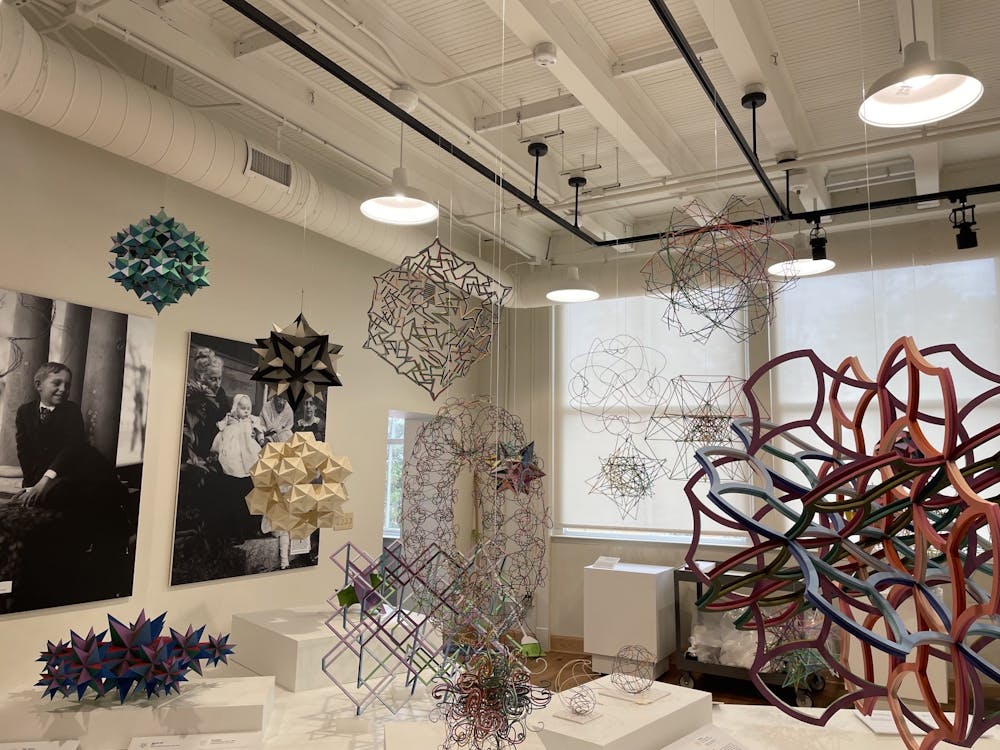The University Collections will debut the “Unity in Variety: The Works of Morton C. Bradley, Jr.” exhibition of geometric sculptures at 5 p.m. Friday at the McCalla Gallery, located on the corner of Ninth Street and Indiana Avenue.
Bradley, born in Massachusetts in 1912, was a mathematician and art conservator. He lived a quiet life in the suburbs of Boston, where he filled his time with art, music, books, travel and friendship, according to the “Color and Form” book about Bradley’s life. Later in life, Bradley began creating the many colorful geometric sculptures now on display in the university collections.
Related: [Constellation Stage and Screen to premiere 17th annual screening of Rocky Horror Picture Show]
While he personally did not spend time in Indiana, Bradley’s great-grandfather was Theophilus Wylie, cousin of Andrew Wylie, who was IU’s first president. The pair were some of the university’s first-ever faculty members. After Bradley passed away in 2004, he donated his artworks to IU. Hundreds of Bradley’s sculptures are stored in the collections and displayed throughout campus. Friday’s exhibition will be the first time Bradley’s work is displayed as a full collection.
Each of the sculptures — multicolored, complex works made from metal, wood and paper — was created using a mathematical equation.
Alisha Beard, the engagement coordinator of campus art, said Bradley and his team calculated each of the equations they used by hand. Because mathematics today is so computerized, Beard said she thinks Bradley’s team was among the last generation to create mathematical figures manually.
She said Bradley’s exhibition is a testament to what different disciplines can learn from one another.
“This is such a beautiful example of math meeting art, two things that you don't think about coming together,” Beard said.
While Bradley wasn’t the one physically assembling these pieces, Katie Chattin, the assistant curator of campus art, said it was his mathematical vision that allowed them to come to life.
“The fact that he surrounded himself with the people that could accomplish this is just as important as dreaming them up,” she said. “Because if not, they're stuck in the mind of someone. But he was able to find the people that could make them a reality.”
For example, Linda Kindler Priest — one of the creators on Bradley’s team and a former jeweler — used her previous experience with delicate brushwork to paint many of the complex pieces after they were assembled. Chattin said this meticulous precision makes these works so impressive.
Because these pieces have never been properly displayed, Chattin said she’s excited to share them with the public, especially with individuals who come from STEM backgrounds.
“When we get the mathematics department faculty in to see these, they immediately see the geometry and the repetition,” Chattin said. “They understand how they were made. Whereas when I look at it, I'm seeing color and form.”
For Chattin, the beauty of Bradley’s work lies in the multiple points of entry for viewers to appreciate it through. Whether it be for their shape, color, math or “dreamlike” quality, people from all backgrounds can engage with the art in some way.
Related: [The Soweto Gospel Choir brought electricity to the IU Auditorium Oct. 18]
Jacob Goode, one of the exhibition preparators, said Bradley’s work reflects the math that surrounds human life. Goode said mathematical patterns and phenomena — the Fibonacci sequence, the magic square, the equivalent ratio from people’s forearms to shoulders — can be found everywhere.
“Life is math,” Goode said.
Bill Bass, another preparator, said he thinks the best part of the work is the human ingenuity behind it. Anyone can create 3-D models of these equations on a computer with current technology, but Bass finds that Bradley’s models have a more personal, engaging touch.
“There's just little bits, goofy things that make them feel craft projects and not little perfect shapes,” Bass said. “I like that better.”
Friday’s reception is free to the public and will offer refreshments. The exhibition will be open until November 2023, and viewers can visit McCalla during its open gallery hours. It is open Tuesday, Wednesday and Friday from noon to 5 p.m. and Thursdays from noon to 7 p.m.




